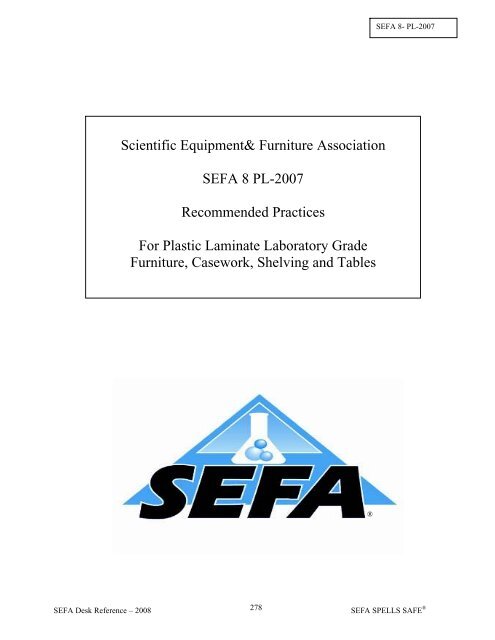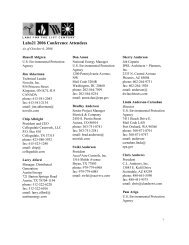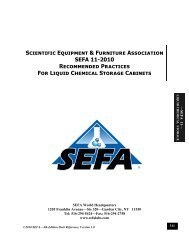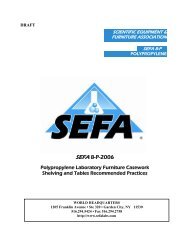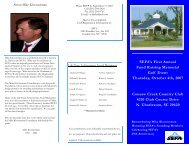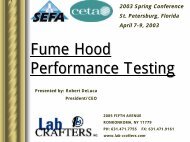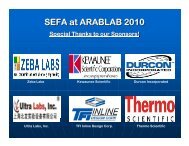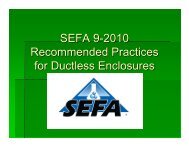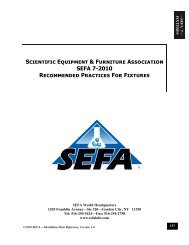Scientific Equipment& Furniture Association SEFA 8 PL-2007 ...
Scientific Equipment& Furniture Association SEFA 8 PL-2007 ...
Scientific Equipment& Furniture Association SEFA 8 PL-2007 ...
- No tags were found...
You also want an ePaper? Increase the reach of your titles
YUMPU automatically turns print PDFs into web optimized ePapers that Google loves.
<strong>SEFA</strong> 8- <strong>PL</strong>-<strong>2007</strong><strong>Scientific</strong> Equipment& <strong>Furniture</strong> <strong>Association</strong><strong>SEFA</strong> 8 <strong>PL</strong>-<strong>2007</strong>Recommended PracticesFor Plastic Laminate Laboratory Grade<strong>Furniture</strong>, Casework, Shelving and Tables®<strong>SEFA</strong> Desk Reference – 2008 278 <strong>SEFA</strong> SPELLS SAFE ®
<strong>SEFA</strong> 8- <strong>PL</strong>-<strong>2007</strong>This document was written with input from the following individuals:Robert Hacker, -Committee Chair…………….……Case Systems, Inc.Kevin Kovash………..................................................TMI Systems Design CorporationChip Albright………………………………………..Collegedale Casework, LLCDave Withee…………………………………………Diversified Woodcrafts, Inc.Steve Frei……………………………………………..Pacific Cabinets, Inc.Donna Frei……………………………………………Pacific Cabinets<strong>SEFA</strong> Desk Reference – 2008 279 <strong>SEFA</strong> SPELLS SAFE ®
280 <strong>SEFA</strong> Desk Reference – 2008 <strong>SEFA</strong> SPELLS SAFE ®<strong>SEFA</strong> 8- <strong>PL</strong>-<strong>2007</strong>TABLE OF CONTENTSFOREWORD………………………………………..282Sections1.0 Scope................................................................283 6.3.3 Acceptance Level6.4 Drawer Cycle Test2.0 Purpose……………………………………….283 6.4.1 Purpose of Test6.4.2 Test Procedure3.0 Definitions……………………………………283 6.4.3 Acceptance Level3.1 Description of Testing Apparatus7.0 Shelving…………..………………………..2904.0 Base Cabinets………………………………...285 7.1 Shelf Load Test4.1 Description of Test Unit 7.1.1 Purpose of Test4.2 Cabinet Load 7.1.2 Test Procedure4.2.1 Purpose of Test 7.1.3 Acceptance Level4.2.2 Test Procedure4.2.3 Acceptance Level 8.0 Cabinet Surface Finish Test ……………2904.3 Cabinet Concentrated Load Test 8.1 Chemical Spot Test4.3.1 Purpose of ‘Test 8.1.1 Purpose of Test4.3.2 Test Procedure 8.1.2 Test Procedure4.3.3 Acceptance Level 8.1.3 Acceptance Level4.4 Cabinet Torsion 8.2 Boiling Water Resistance Test4.4.1 Purpose of Test 8.2.1 Purpose of Test4.4.2 Test Procedure 8.2.2 Test Procedure4.4.3 Acceptance Level 8.2.3 Acceptance Level4.5 Cabinet Submersion Test 8.3 Ball Impact Test4.5.1 Purpose of Test 8.3.1 Purpose of Test4.5.2 Test Procedure 8.3.2 Test Procedure4.5.3 Acceptance Level 8.3.3 Acceptance Level8.4 Dart Impact Test5.0 Doors…………………………………………288 8.4.1 Purpose of Test5.1 Door Hinge Test 8.4.2 Test Procedure5.1.1 Purpose of Test 8.4.3 Acceptance Level5.1.2 Test Procedure 8.5 Edge Delaminating Tests5.1.3 Acceptance Level 8.5.1 Purpose of Test5.2 Door Cycle Test 8.5.2 Test Procedures5.2.1 Purpose of Test 8.5.3 Acceptance Level5.2.2 Test Procedure 8.6 Edge Impact Test5.2.3 Acceptance Level 8.6.1 Purpose of Test8.6.2 Test Procedure6.0 Drawers…………………………………………289 8.6.3 Acceptance Level6.1 Drawer Static Test 8.7 Wear Resistance (Abrasion) Test6.1.1 Purpose of Test 8.7.1 Purpose of Test6.1.2 Test Procedure 8.7.2 Test Procedure6.1.3 Acceptance Level 8.7.3 Acceptance Level6.2 Drawer Impact Test6.2.1 Purpose of Test 9.0 Wall Cabinets, Counter Mounted6.2.2 Test Procedure and Tall Units……………………………..2936.2.3 Acceptance Level 9.1 Description of Test Unit6.3 Drawer Internal Rolling Impact 9.2 Load Test6.3.1 Purpose of Test 9.2.1 Purpose of Test6.3.2 Test Procedure
9.2.2 Test Procedure9.2.3 Acceptance Level10.0 Tables………………………………………29410.1 Description of Test Unit10.2 Load Test10.2.1 Purpose of Test10.2.2 Test Procedure10.2.3 Acceptance Level10.3 Table Racking10.3.1 Purpose of Test10.3.2 Test Procedure10.3.3 Acceptance Level<strong>SEFA</strong> 8- <strong>PL</strong>-<strong>2007</strong><strong>SEFA</strong> Desk Reference – 2008 281 <strong>SEFA</strong> SPELLS SAFE ®
282 <strong>SEFA</strong> Desk Reference – 2008 <strong>SEFA</strong> SPELLS SAFE ®<strong>SEFA</strong> 8- <strong>PL</strong>-<strong>2007</strong>FOREWORD<strong>SEFA</strong> ProfileThe <strong>Scientific</strong> Equipment and <strong>Furniture</strong> <strong>Association</strong><strong>SEFA</strong> Recommended Practices<strong>SEFA</strong> and its committees are active in the(<strong>SEFA</strong>) is a voluntary international trade development and promotion of recommendedassociation representing members of the laboratory practices having domestic and internationalfurniture, casework, fume hood and related applications. Recommended practices areequipment industry. The association was founded developed by the association taking into account theto promote this rapidly expanding industry and to work of other national standard-writingimprove the quality, safety and timely completionof laboratory facilities in accordance with customerneeds and requirements.<strong>SEFA</strong> Glossary of Termsorganizations. Liaison is also maintained withgovernment agencies in the development of theirspecifications.<strong>SEFA</strong>’s recommended practices are developed inand for the public interest. These practices are<strong>SEFA</strong> has developed a glossary of terms for thepurpose of promoting a greater understandingbetween designers, architects, manufacturers,purchasers and end users. The terms defined by<strong>SEFA</strong> are frequently used in contracts and otherdocuments, which attempt to define the products tobe furnished or the work involved. The associationhas approved this glossary in an effort to provideuniformity among those who use these terms.designed to promote better understanding betweendesigners, architects, manufacturers, purchasers,and end users to assist the purchaser in selectingand specifying the proper product to meet the user’sparticular needs. The existence of a <strong>SEFA</strong>recommended practice does not preclude anymember or non-member from providing products orservices that do not conform to these recommendedpractices and encourages all interested parties toparticipate in the important endeavor.<strong>SEFA</strong> encourages all interested parties to submitadditional terms or to suggest any changes to thoseterms already defined by the association. Theglossary should be used to help resolve any disputesthat may rise or to incorporate the applicable terms<strong>SEFA</strong>’s recommended practices and the glossary ofterms are copyrighted and may be disseminated fortheir widest possible use by the quoting orphotocopying whenever necessary.in any contract or related documents.
<strong>SEFA</strong> 8- <strong>PL</strong>-<strong>2007</strong>1.0 ScopeThe scope of this document is intended to providemanufactures, specifiers, and users tools forevaluating the safety, durability, and structuralintegrity of plastic laminate laboratory gradefurniture and complimentary items. This documentis inclusive of casework (base units, wall mountedunits, counter mounted units, tall units, tables and,shelving systems). Casework, tables, and shelvingmanufactured for laboratory use should besubjected to the tests and procedures outlinedbelow.<strong>SEFA</strong>-8<strong>PL</strong> Plastic laminate laboratory gradecasework shall consist of base cabinets, wallcabinets, counter mounted cabinets, tall cabinets,tables, and shelving and shall be constructed of acore, high pressure laminate, backer, liner orthermally fused melamine. A plastic laminatecabinet consists of top, bottom, end members and aback.Aggregate test results may vary by manufacturer.Procedures for testing performance criteria shall beas outlined in this document and results madeavailable upon request. It is assumed that the testmodel reflects the performance criteria for allproducts. However there may be certaindoor/drawer configurations and/or sizes outside thetest unit configuration identified that may not meetcertain parts of this test. A test unit has beenidentified in this document with the sole purpose ofobtaining continuity of procedures and results in ascientific format.Great care should be exercised when heavy loadsare applied to the cabinet and appropriate safetyprecautions taken to insure safety of testingpersonnel. Properly trained personnel shouldperform all tests. <strong>SEFA</strong> assumes no liability fordamage or injury as a result of conducting thesetests.The acceptance levels are based on the cumulativefield experience and laboratory testing of <strong>SEFA</strong>members based on actual needs of laboratories.This is a performance-based document.Specifications proscribing specific materials,hardware, finishes, workmanship orconstruction may or may not meet acceptancelevels of this document. If proscriptivecomponents of the specifications conflict withcompliance of this document then theArchitectural proscribed elements takeprecedent.Test results as outlined in this document shall beperformed and documented by <strong>SEFA</strong> approvedtesting facilities.2.0 PurposeThe purpose of this document is to describe thedistinguishing performance characteristics of plasticlaminate laboratory grade casework and shall be ofa type specifically designed and manufactured forinstallation and use in a laboratory.3.0 DefinitionsAcceptance Levels - The acceptance level for eachperformance criteria is based on the cumulativeexperience of actual field-testing and laboratoryresults of <strong>SEFA</strong> members. Acceptance levelsdescribe the expected outcome of each testprocedure.ANSI - ANSI is the American National StandardsInstitute. Approval of an American NationalStandard requires verification by ANSI that therequirements for due process, consensus, and othercriteria for approval have been met by the standardsdeveloper.Apparatus - A machine or group of machines andaccessories.Arithmetic Mean - A number obtained by dividingthe sum of a set of quantities by the number ofquantities in a set; average. 1ASTM - ASTM is the American Society forTesting and Materials.283<strong>SEFA</strong> Desk Reference – 2008 <strong>SEFA</strong> SPELLS SAFE ®
<strong>SEFA</strong> 8- <strong>PL</strong>-<strong>2007</strong>Base Cabinets - A base cabinet is always mountedon the floor and normally supports a work surface.The top surface is normally no more than 39"(990.6 mm) off the floor surface.Cabinet - A storage devise consisting of a front,bottom, two sides, and a top.Cabinet Depth - The cabinet depth is the outsidedimension of the cabinet from face to backexcluding the door/drawer fronts.Cabinet Height - The cabinet height is the overalldimension of the cabinet side from the bottom to thetop excluding work surface.Cabinet Width - The overall dimension of acabinet as measured horizontally at the front in itsnormal upright position from one side to the other.Casework – The term used to refer to base cabinets,wall cabinets, tall cabinets and shelving.Laboratory Casework - Casework specificallydesigned, engineered and manufactured forinstallation and use in a laboratory.Medium Density Fiberboard (MDF) - Woodparticles reduced to fibers in a moderate pressuresteam vessel combined with a resin, and bondedtogether under heat and pressure.3Permanent Damage - Destruction to material orjoinery that would require repair in order to returnto its original state.Chase (Utilities Area) - Space located behind theback of the base cabinet used to house plumbing,data cables or electric lines.Core - Any substrate between two laminate faces.Counter Mounted Cabinet - A counter mountedcabinet is a wall cabinet (usually with a height ofapproximately 48" [1,219.2mm] and is typicallymounted on the work surface or shelf, as in areagent shelf).Drawer - A sliding storage box or receptacleopened by pulling out and closed by pushing in.2Edge – Material of varying thickness commonlyused to provide protection and seal the machinededge(s) of laminated panels. Typical edge materialsare ABS, PVC, self-edge, or wood.Free Standing - Requiring no support or fasteningto other structures.Hardware - Items such as screws, pulls, hinges,latches, locks, and drawer slides used in theconstruction of casework.Joinery - The junction of two pieces intended to bepermanently connected.Leveling Screws (Levelers) - Threadedcomponents designed to allow vertical adjustmentof a casework item.Permanent Deformation - Deflection that hasexceeded the plastic limit, thus changing theoriginal shape of the product.Permanent Deterioration - Erosion or corrosion ofmaterial such that the component will never returnto its original shape.Permanent Failure - See "permanent damage."Plywood - The term plywood is defined as a panelmanufactured of three or more layers (plies) ofwood or wood products (veneers or overlays and/orcore materials), generally laminated into a singlesheet (panel). Plywood is separated into two groupsaccording to materials and manufacturing,hardwood plywood and softwood plywood.Pulls - Articles of hardware used to grasp andopen/close the door or drawer (see also hardware).Rack Resistance - The ability of the product toresist stresses that tend to permanently damage ordeform.Rail - A horizontal member extending from oneside of the cabinet to the other.Reagent - A substance used because of its chemicalor biological activity.9284<strong>SEFA</strong> Desk Reference – 2008 <strong>SEFA</strong> SPELLS SAFE ®
<strong>SEFA</strong> 8- <strong>PL</strong>-<strong>2007</strong>Removable Back - A panel located on the insideback of the base cabinet, which is removable inorder to gain access to utilities.Shelving - A horizontal surface in a cabinet, on orabove a cabinet, or on a wall used to hold objects.Submersion - Covered with water.Tall Cabinet (Full Height Unit) - A cabinet that isalways mounted on the floor and is nominally 84"(2,133.6mm) high.Torsion - The act or state of being twisted.Unobstructed Entry - A cabinet is deemed to beunobstructed if access to the entire storage area iscompletely without obstacle.Upright Position - A cabinet oriented in itsintended position and use.Wall Cabinet – A cabinet that is always mountedon a vertical surface such as a wall, panel, orvertical support system. A wall cabinet is usuallyless than 48" (1,219.2mm) high and 16” deep.Work Surface - A horizontal surface used tosupport apparatus at a convenient height off thefloor. Work surfaces are normally positioned atop abase cabinet or table structure.3.1 Description of Testing ApparatusSolid Steel Bar - A square solid steel bar 2 1/2"(63.5mm) square, 28 1/4" (717.55mm) long,weighing 50 pounds (22.679 Kg).Sand or Shot Bag (10 pounds [4.535 Kg]) - A bagof plastic or cloth with the approximate dimensions10 9/16" (2683mm) x 11" (2790mm) as in typical"gallon size reclosable storage bags." Fill withenough sand or shot so that contents weigh 10pounds (4.535 Kg).Sand Bag (20 pounds [9.071 Kg]) - Two 10 pound(4.535 Kg) sand bags bound together.Shot Bag (80 lbs. [36.287 Kg]) - A plastic or clothbag of sufficient size to contain 80 pounds (36.287Kg) of shot.Cycling Mechanism - Per ANSI A156.9.Steel Rod - A 2" (50.8mm) diameter by 12"(304.8mm) long rod, approximately 10 pounds(4.535Kg) in weight.Hardwood Corner Block - A block of hardwood2" (50.8mm) square by 1" (25.4mm) high.4.0 Base CabinetsThe base cabinet shall be a combination of twodoors and one drawer per Figure 1. The basecabinet shall be 48" +/- 1” wide, 36" +/-1” high, and22" +/-1” deep. Cabinet dimensions do not includedrawer or door thickness. The drawer shall beabove the two doors, full width and approximatelyone-fourth the height of the cabinet's face opening.The base cabinet shall be a double-door design andprovide unobstructed entry into the cabinet interiorwith the doors open. The unit shall contain oneadjustable shelf. The cabinet back shall be theremovable type (per manufactures standard designas used for access to the utilities or chase area) withthe removable panel removed. The removablepanel shall be a minimum size of 36”x18”.4.1 Description of Test UnitThe cabinet shall be free standing, squared andsitting 1" (25.4mm) off the floor atop fourhardwood corner blocks 2" (50.8mm) square and 1"(25.4mm) high. A top of 1" (25.4mm) thick 37-50pcf medium density fiberboard shall be positionedon the cabinet without glue or fasteners of any kind.The top dimensions will be such that it willoverhang the cabinet perimeter by 1" (25.4mm).Before conducting the test, a visual examinationshall be conducted to verify that the unitconfiguration and setup conditions are appropriate.Operate doors and drawer. Doors should be freemoving and latch properly. Inspect the unit fordimensions and note the fit of doors and drawers tothe cabinet body. Open and close the drawer. The285<strong>SEFA</strong> Desk Reference – 2008 <strong>SEFA</strong> SPELLS SAFE ®
<strong>SEFA</strong> 8- <strong>PL</strong>-<strong>2007</strong>drawer should be free moving and function asspecified by the manufacturer. See figure 1.2” x 2” x 1” Mounted blocks at each corner below base.Figure 1 Base Cabinet4.2 Cabinet Load Test4.2.1 Purpose of TestThe cabinet load test will challenge the structuralintegrity and load bearing capability. This test willdemonstrate the ability of the cabinet to supportheavy applied loads. This is not intended to test thefunctional characteristics of the cabinet under heavyloads.4.2.2 Test ProcedureVerify that the cabinet is level. Remove drawer andopen doors for testing purpose. Load the cabinettop by using 2000 pounds (907.185 Kg) of solidsteel bars (per Section 3.1) stacked four high andspaced per Figure 2. After 24 hours, unload thecabinet.Figure 2 Cabinet Load Test4.2.3 Acceptance LevelThe cabinet will have no signs of permanent failure.4.3 Cabinet Concentrated Load Test4.3.1 Purpose of TestThe purpose of this test is to challenge thefunctional characteristics of the cabinet whensubjected to a concentrated load on the center of thecabinet top.4.3.2 Test ProcedureUsing solid weights, apply a total of 200 pounds(90.718 Kg) to the top of the cabinet along thecabinet centerline (see Figure 3). After a period of24 hours before removal of test load, operate doorsand drawers.286<strong>SEFA</strong> Desk Reference – 2008 <strong>SEFA</strong> SPELLS SAFE ®
<strong>SEFA</strong> 8- <strong>PL</strong>-<strong>2007</strong>Figure 3Concentrated Load Test4.3.3 Acceptance LevelUnder condition of test load, doors and drawer shalloperate normally.4.4 Cabinet Torsion4.4.1 Purpose of TestThis test will evaluate the structural integrity of thecabinet construction when subjected to a torsionalload.4.4.2 Test ProcedureThe cabinet shall be tested in its normal uprightposition, raised not less than four-inches off thefloor and supported on rear and one front corner.The area of support under the cabinet shall belocated not more than 6" (152.4mm) in from eachsupported corner. Secure the cabinet diagonallyfrom the unsupported corner with seven solid steelbars per Section 3.1 (350 pounds (158.757 Kg) ofweight), on the top of the cabinet to preventoverturning. Apply four solid steel bars (200pounds [90.718 Kg] of weight) to the unsupportedcorner for a period of 24 hours (see Figure 4).Remove weight and place cabinet on the floor in itsnormal upright position. Observe cabinet joinery.Level the cabinet and measure the face and back ofthe cabinet across the diagonal corners.Figure 4 Cabinet Torsion Test4.4.3 Acceptance LevelWhen returned to normal position, the operation ofthe cabinet shall be normal, and there will be nosigns of permanent damage. The differencebetween the two measurements taken frommeasuring the diagonal corners shall be no morethan 1/8" (3.175mm).4.5 Cabinet Submersion TestThere are numerous options for removable bases orladder type bases with plastic laminate casework,including exterior grade plywood, MR board,composites, etc. Standard 1-M-3 particleboard isnot recommended if the possibility of standingwater is an issue.4.5.1 Purpose of TestThis test will demonstrate the ability of a cabinetto resist standing water. Only floor standingcabinets should be subjected to this test.4.5.2 Test ProcedureThe material thickness along the perimeter of thecabinet shall be measured at 6" (152.4mm)increments. Record the thickness of the material tobe submerged in water. Calculate the arithmeticmean of the data taken. Place the entire test cabinetin its upright position such that the cabinet issubmerged 2” above the bottom of the removable287<strong>SEFA</strong> Desk Reference – 2008 <strong>SEFA</strong> SPELLS SAFE ®
<strong>SEFA</strong> 8- <strong>PL</strong>-<strong>2007</strong>base. Cabinet doors are removed for this test. After24 hours, remove the unit from the water. After 48hours of drying time, measure the thickness of thematerial at the same points measured initially.Calculate the new arithmetic mean. After the unithas been allowed to dry, inspect for other damage.No Illustration.4.5.3 Acceptance LevelThe cabinet base shall show no signs of permanentdeformation or deterioration. Increase in thicknessshall not exceed four percent of the initial meanmeasurements.5.0 Doors5.1 Door Hinge Test5.1.1 Purpose of TestThis test will demonstrate the durability of the door,door attachment and its hardware (hinge leaf,screws, etc.) to an applied load of 160 pounds(72.575 Kg).5.1.2 Test ProcedureRemove the shelf for this test. With unit and top setas described in Section 4.1, add sufficient weight tothe top in order to prevent overturning. Withcabinet door opened 90-degrees, hang a sling madeup of two 80 pound (36.287 Kg) weights (shot bagsor solid weights) over top of the door at a point 12"(304.8mm) out from the hinge centerline (seeFigure 5). Slowly move door through two cycles ofthe hinge at 160-degree arc. Remove weight andswing door through its full-intended range ofmotion and close door.Figure 5Cabinet Door Hinge TestCertain unit configurations require hinge location tobe such that load ratings can be lower than the testmodel. See manufacturer for details.5.2 Door Cycle Test5.2.1 Purpose of TestThis test will demonstrate the durability of the doorhinge hardware to withstand 100,000 cycles (as areliable measure for longevity).5.2.2 Test ProcedureThis test shall conform to the ANSI test procedureA156.9, Grade 1 requirements for cycle testing ofdoors. A cycling mechanism shall swing the door90-degrees. The door shall operate for 100,000cycles continuously, without hinge adjustment, at aspeed of 15 cycles per minute. No illustration.5.1.3 Acceptance LevelThe open door shall withstand a load of 160 pounds(72.73 Kg) when applied at a point 12" (304.8mm)from the hinge centerline without permanentdamage. Operation of the door, after test, shallshow no significant permanent damage that willcause binding of the door or hinges or that willadversely affect operation of the catch*.288<strong>SEFA</strong> Desk Reference – 2008 <strong>SEFA</strong> SPELLS SAFE ®
<strong>SEFA</strong> 8- <strong>PL</strong>-<strong>2007</strong>5.2.3 Acceptance LevelThe door shall operate for the full cycle periodwithout deterioration that will affect the function ofthe door. The door shall operate freely withoutbinding.6.0 Drawers6.1 Drawer Static Test6.1.1 Purpose of TestThis test will demonstrate the ability to support apoint load given to the front of the drawer and willchallenge the drawer suspension system and theattachment of the drawer head to the drawer and therelated hardware.6.1.2 Test ProcedureWith unit and top set as described in Section 4.1,add sufficient weight to the top in order to preventoverturning. Open the drawer to 13" (330.2mm) oftravel and hang 150 pounds (68.03 Kg) from thedrawer head at the centerline of the drawer for fiveminutes Remove the weight and operate the drawerthrough the full cycle. See Figure 6.6.1.3 Acceptance LevelThere shall be no permanent damage that willinterfere with the normal operation of the drawerand the drawer head should remain tightly fastenedto the drawer.6.2 Drawer Impact Test6.2.1 Purpose of TestThis test will demonstrate the resistance to impactof the drawer bottom.6.2.2 Test ProcedureRemove drawer; support each corner with 2”x2”x1”supports. Drop 10 lbs. sand or shot bag from aheight of 24” into the bottom of the drawer at thecenter of the width of the drawer. Remove the sandor shot bag. No illustration.6.2.3 Acceptance LevelNo permanent damage shall be observed.6.3 Drawer Internal Rolling Impact6.3.1 Purpose of TestThis test will evaluate the strength of the drawerhead, bottom, and back as a result of opening andclosing the drawer with a rolling load.6.3.2 Test ProcedureFigure 6Drawer Static testPosition the drawer on a table at a 45-degree angleper Figure 7. Place a 2"(50.8mm) diameter by12"(304.8mm) long steel rod (approximately 10pounds [4.535 Kg]) 13" (330.2mm) from the targetimpact area such that the rod will roll freely toimpact the back of the drawer. Subject the back tothree impacts and reverse the drawer to subject thefront to three additional impacts6.3.3 Acceptance Level289<strong>SEFA</strong> Desk Reference – 2008 <strong>SEFA</strong> SPELLS SAFE ®
<strong>SEFA</strong> 8- <strong>PL</strong>-<strong>2007</strong>The drawer shall show no signs (other than minorscratches and dents) of permanent damage. Alljoinery shall be intact and the drawer, whenreplaced in the unit, shall operate normally. Minorscratches and dents are acceptable.activate hardware. The load rating in this documentis intended only for testing conditions where loadschallenge the durability of the hardware. Underactual conditions, drawer loading should be reducedto levels that result in compliance with ADA asapplicable.7.0 Shelving7.1 Shelf Load Test7.1.1 Purpose of TestThis test will demonstrate the ability of a shelf andits mounting hardware to support loads of 40pounds (18.144 Kg) per square foot, not to exceed200 pounds (90.718 Kg).Figure 7Drawer Internal Rolling Test6.4 Drawer Cycle Test6.4.1 Purpose of TestThis test is intended to replicate years ofoperation of a drawer under full load.6.4.2 Test ProcedureA static load of 100 pounds (45.359 Kg) (using ten10 pound [4.535 Kg] sand bags per Section 3.1)shall be uniformly distributed in the drawer.Measure force required to activate the drawer.Operate from a closed position to within 1/4"(6.35mm) of full extension for 50,000 cycles at arate not to exceed 10 cycles per minute. Noillustration.6.4.3 Acceptance LevelThe drawer shall operate freely without evidence ofdragging rubbing or binding. The force required toopen and close loaded drawer shall not be greaterthan 8 pounds (3.629 Kg) to activate hardware.Note: The American's with Disabilities Act (ADA)requires a force no greater than five pounds to7.1.2 Test ProcedureA shelf shall be mounted in a manner in which it isdesigned. Measure the distance from the undersideof the shelf to a reference point perpendicular to thecenter of the shelf. Use shot or sand bags weighing10 pounds (4.535 Kg) each. Unless otherwisespecified, load the shelf uniformly to 40 pounds(18.14 kg) per square foot of shelf area to amaximum of 200 pounds (90.71 Kg). Measure thedeflection of the shelf by measuring the distance tothe reference point and calculating the differencebetween the two measurements. Record data andremove the load from the shelf. No illustration.7.1.3 Acceptance LevelDifferent materials will perform differently to theloads based on the Modulus of Elasticity of thematerial and the cross section moment of inertiafor the shape of the material. Longer shelves willsupport less loads than shorter shelves. Theallowable maximum deflection of a shelf is 1/180of the span and not in excess of .25” (6.35mm).8.0 Cabinet Surface Finish Tests8.1 Chemical Spot Test8.1.1 Purpose of TestThe purpose of the chemical spot test is to evaluatethe resistance a finish has to chemical spills.290<strong>SEFA</strong> Desk Reference – 2008 <strong>SEFA</strong> SPELLS SAFE ®
<strong>SEFA</strong> 8- <strong>PL</strong>-<strong>2007</strong>8.1.2 Test ProcedurePlastic laminate samples shall be as follows: onesample of a core material with a high pressurelaminate (VG335 Finish) on the side to be testedand backer or liner on the opposite side, a secondsample of a core material with a high pressurelaminate (VG 78 Finish) on the side to be tested anda third sample with CHEM SURF high pressurelaminate on the side to be tested and backer or lineron the opposite side.Place each panel on a flat surface, clean with soapand water and blot dry. Condition the panel for 48-hours at 73°+ 3°F (23°+ 2°C) and 50+ 5% relativehumidity. Test the panels for chemical resistanceusing forty-nine different chemical reagents by oneof the following methods:Method A - Test volatile chemicals by placing acotton ball saturated with reagent in the mouth of a1-oz. (29.574cc) bottle and inverting the bottle onthe surface of the panel.Method B - Test non-volatile chemicals by placingfive drops and covering with a 24mm watch glass,convex side down.For both of the methods, leave the reagents on thepanel for a period of one hour. Wash off the panelwith water, clean with detergent and naptha, andrinse with deionized water.Dry with a towel of the reagent on the surface of thepanel and evaluate after 24-hours at 73+ 3ºF (23 +2ºC) and 50+ 5% relative humidity using thefollowing rating system.Level 0 - No detectable change.Level 1 - Slight change in color or gloss.Level 2 - Slight surface etching or severestaining.Level 3 - Pitting, cratering, swelling, orerosion of coating. Obvious andsignificant deteriorationChemical ReagentTestMethodRatingVG335FinishRatingVG78FinishRatingCHEMSURF1. Acetate, Amyl A 0 0 02. Acetate, Ethyl A 0 0 03. Acetic Acid, 98% B 0 0 04. Acetone A 0 0 05. Acid Dichromate, B 2 1 05%6. Alcohol, Butyl A 0 0 07. Alcohol, Ethyl A 0 0 06. Alcohol, Buyl A 0 0 08. Alcohol, Methyl A 0 0 09. AluminumB 0 0 0Hydroxide, 28%10. Benzene A 0 0 011. CarbonA 0 0 0Tetrachloride12. Chloroform A 0 1 013. Chromic Acid, 60% B 0 0 114. Cresol A 0 0 015. Dichlor Acetic Acid A 0 0 016. Dimethylformanide A 0 0 017. Dioxane A 0 0 018. Ethyl Ether A 0 0 019. Formaldehyde, 37% A 0 0 020. Formic Acid, 90% B 2 2 021. Furfural A 2 0 022. Gasoline A 0 0 023. Hydrochloric Acid, B 2 2 037%24. Hydrofluoric Acid, B 2 3 148%25. Hydrogen Peroxide, B 0 0 03%26. Iodine, Tincture of B 0 0 027. Methyl Ethyl A 0 0 0Ketone28. Methylene Chloride A 0 0 029. MonoA 0 0 0Chlorobenzene30. Naphthalene A 0 0 031. Nitric Acid, 20% B 2 2 232. Nitric Acid, 30% B 2 2 233. Nitric Acid, 70% B 2 3 234. Phenol, 90% A 1 0 035. Phosphoric Acid, B 2 2 085%36. Silver Nitrate, B 0 2 0Saturated37. Sodium Hydroxide, B 1 0 210%38. Sodium Hydroxide, B 0 1 220%39. Sodium Hydroxide, B 0 1 240%40. Sodium Hydroxide, B 0 0 2Flake41. Sodium Sulfide, B 0 0 0Saturated42. Sulfuric Acid, 33% B 1 1 243. Sulfuric Acid, 77% B 1 3 244. Sulfuric Acid 96% B 3 3 245. Sulfuric Acid B 2 3 0(77%)and NitricAcid (70%), equalparts46. Toluene A 0 1 0291<strong>SEFA</strong> Desk Reference – 2008 <strong>SEFA</strong> SPELLS SAFE ®
<strong>SEFA</strong> 8- <strong>PL</strong>-<strong>2007</strong>47. Trichloroethylene A 0 1 048. Xylene A 0 0 049. Zinc Chloride, B 0 0 0Saturated8.1.3 Acceptance LevelResults will vary from manufacturer tomanufacturer. Laboratory grade finishes shouldresult in no more than four Level 3 conditions.Suitability for a given application is dependentupon the chemicals used in a given laboratory.8.2 Boiling Water Resistance Test8.2.1 Purpose of TestThe purpose of this test is to measure the ability ofhigh-pressure laminate to maintain its color andsurface finish when subjected to boiling water.8.2.2 Test ProcedureThis test procedure is outlined in ANSI/NEMA LD3-2005 Para 3.5 Boiling Water Resistance. Noillustration.8.2.3 Acceptance LevelAcceptance level as defined in ANSI/NEMA LD 3-2005 Para 3.5 Boiling Water Resistance.No effect-no change in color or surface finish.118.3 Ball Impact Resistance Test8.3.1 Purpose of TestThe purpose of this test is to measure the ability ofhigh-pressure laminate to resist fractures due toimpact by a large diameter ball.8.3.2 Test ProcedureThis test procedure is outlined in ANSI/NEMA LD3-2005 Para 3.8 Ball Impact Resistance. Noillustration.8.3.3 Acceptance LevelThe report shall indicate the actual height of impactresistance. Minimum of 50” (1250mm)118.4 Dart Impact Resistance Test8.4.1 Purpose of TestThe purpose of the test is to measure the ability ofhigh-pressure laminate to resist fracture due to asmall diameter ball.8.4.2 Test ProcedurePer ANSI/NEMA LD 3-2005 Para 3.9. Noillustration.8.4.3 Acceptance LevelPer ANSI/NEMA LD 3-2005 Para 3.9. The impactresistance value shall be reported in millimeters.Minimum of 500mm (20”)118.5 Edge Delaminating Tests8.5.1 Purpose of TestThe purpose of this test is to evaluate the adhesionstrength between the edge and the core material.8.5.2 Test ProcedureMount test specimens in Instron force gauge jaws topull the edge close to 90 degrees to the bond line ofthe banding, this angle may be varied based on theflexibility of the edge material. Measure the forcerequired to separate the edge from the specimen. 2-inch X 6-inch panels with 13-inch edge banding,see Figures 8 and 9.Figure 8Edge Delaminating Test SpecimenAcceptance level as defined in ANSI/NEMA LD 3-2005 Para 3.8 Ball Impact Resistance.292<strong>SEFA</strong> Desk Reference – 2008 <strong>SEFA</strong> SPELLS SAFE ®
<strong>SEFA</strong> 8- <strong>PL</strong>-<strong>2007</strong>8.7 Wear Resistance (Abrasion) Test8.7.1 Purpose of TestThis test measures the ability of high-pressurelaminate to resist abrasive wear-through of thedecorative layer.8.7.2 Test ProcedureFigure 9Edge Delaminating Test and Setup8.5.3 Acceptance LevelPeel value must be greater than 18.5 lbs/in.8.6 Edge Impact Test8.6.1 Purpose of TestThe purpose of this test is to demonstrate theresilience of the 3 mm PVC edge band material.8.6.2 Test ProcedureInsert test specimen with 3mm edge band facingthe front into fixture, raise arm to stop, releasePer ANSI/NEMA LD 3-2005 Para 3.138.7.3 Acceptance LevelPer ANSI/NEMA LD 3-2005 Para 3.139.0 Wall Cabinets, Counter Mounted,and Tall Units9.1 Description of Test UnitEvaluation shall be conducted on a wall mountedcabinet with nominal dimensions as follows: 48"(1,219.2mm) wide, 30" (762mm) high, and 12"(304.8mm) deep. The wall cabinet shall bemanufactured to manufacturers' standardconstruction and practices. The wall cabinet shallhave two swinging doors, designed in such a waythat when the doors are open, access to cabinet isunobstructed (see Figure 11). Door loadingprocedures are outlined under Section 5.0 (Doors).The wall cabinet will be provided with themanufacturer's standard number of shelves. Shelvesshall be evaluated per Section 7.0 (Shelves). Theunit and shelves shall be mounted in a mannerrecommended by the manufacturer.arm. See Figure 10.Figure 10Edge Impact Test8.6.3 Acceptance LevelThere shall be no signs of damage to the 3 mmedge banding that was applied to the testspecimen.9.2.1 Purpose of TestThe wall mounted load test will demonstrate thestrength of the back of the wall cabinet as well asthe joinery of the cabinet and function of doorswhen the unit is subjected to loads normallyexpected for laboratory furniture.293<strong>SEFA</strong> Desk Reference – 2008 <strong>SEFA</strong> SPELLS SAFE ®
<strong>SEFA</strong> 8- <strong>PL</strong>-<strong>2007</strong>Figure 11 Wall Cabinet9.2.2 Test ProcedureUsing sand or shot bags weighing 10 pounds (4.55Kg) each, load cabinet bottom, each shelf, and topuniformly with 40 pounds (18.18 Kg) per squarefoot to a maximum of 200 pounds (90.91 Kg) each.Maximum load to any cabinet shall not exceed 600pounds (272.73 Kg) (a maximum of 200 pounds[90.91 Kg] loaded to each bottom, a minimum ofone shelf loaded per Section 7.0, and the top)regardless of the number of shelves.mounted on the table in a mannerrecommended by the manufacturer. The topdimensions will be such that it will overhangthe cabinet perimeter by 1". Its weight shall beincluded in the test as live load. A very largerange of styles and designs can represent tables.Products inclusive in this section of testing are:Free Standing Tables, Desks, Aprons mountedbetween two fixed areas such as a wall orCasework, Mobile Tables (Free StandingTables on wheels or casters), Mobile UnderCounter Units, Mobile Workstations,Adjustable Tables, Modular Tables, C-FrameTables, L-Frame Tables, J-Frame Tables, andTables for systems furniture. These tablesystems can all be classified as one of threetypes of tables; Fixed, Free Standing, andmobile. See figure 12.9.2.3 Acceptance LevelWith weights in place, operate doors through fulltravel to verify normal operation of doors. Removeweights and operate doors to verify normaloperation. Verify that there is no significantpermanent deflection of cabinet top, cabinet back,cabinet bottom, or shelves. After weights areremoved, the cabinet shall show no permanentdamage to the cabinet, cabinet bottom, or shelves.10.0 Tables10.1 Description of Test UnitThe table for evaluation shall be a standingheight, four legged, freestanding table. Thetable shall be nominally 60" (1,524mm) long,24" (609.6mm) deep, and 36" (914.4mm) high(see Figure 12). Leg and apron size andconstruction shall be to manufacturer'sspecification. A top of 1" (25.4mm) thick 37 -50 pcf medium density fiberboard shall beFigure 12Table Test Unit10.2 Table Static Load10.2.1 Test Purpose of TestThis test will challenge the table components toloads that are normal for use in a laboratory.10.2.2 Test ProcedureLoad the tabletop by using solid steel bars (perSection 3.1), each weighing 50 pounds (22.679294<strong>SEFA</strong> Desk Reference – 2008 <strong>SEFA</strong> SPELLS SAFE ®
<strong>SEFA</strong> 8- <strong>PL</strong>-<strong>2007</strong>Kg), stacked evenly and spaced per Figure 13.Load the table to the manufacturer'srecommended live load*. These evenlydistributed loads should be no less than 300pounds (136.077 Kg) for mobile, 600 pounds(272.155 Kg) for free standing and 2000pounds (907.184 Kg) for fixed. Include theweight of the working surface as live load.* Table load will vary considerably. Factorsimpacting live load capability include the sizeof the table, material, amount of drawers andbook compartments, glide or caster load rating.Contact manufacturer for live loadspecifications. See figure 1310.3 Table Racking10.3.1 Purpose of TestThis test will demonstrate the structuralintegrity of the table construction whensubjected to a racking load. Most rackingfailures occur upon dragging an unloaded tableacross a floor. The ability of a table to resist aracking load will indicate less damage to thestructure. The following tests were based onand adapted from ANSI/BIFMA X5.5-1989American National Standard for OfficeFurnishings "Desk Products-Tests."Adjustments have been made to betteraccommodate the specific applications of tablesused in laboratories. See figure 14.Figure 14Table Racking TestFigure 13Table Static Load Test10.2.3 Acceptance LevelNo structural breakage shall result fromapplication of the load. With the full load, theapron rails shall not deflect more than 1/360 ofthe span of the table and not to exceed 1/8"(3.175mm). In the case of a table with adrawer, the deflection of the rail shall notinterfere with the function of the drawer. Afterthe load is removed, inspect the table forstructural damage.10.3.2 Test ProcedureThe table shall have a common two-by-fourwood rail clamped on the centerline of the topparallel to the ends of the table. The table shallthen be positioned at 45º, with one pair of legson the floor and the other raised and supported(see Figure 14). The table shall then have 250pounds (113.398 Kg) of weight (five 50-pound(22.679 Kg) bars) placed on its top and held inplace by the two-by-four wood rail. The unitshall remain in this position for seventy-twohours. The unit shall be lowered without shock295<strong>SEFA</strong> Desk Reference – 2008 <strong>SEFA</strong> SPELLS SAFE ®
<strong>SEFA</strong> 8- <strong>PL</strong>-<strong>2007</strong>to the leveled surface and the general operationof the drawers shall be evaluated.10.3.3 Acceptance LevelWhen returned to normal position, theoperation of the table shall be normal, and therewill be no permanent damage.296<strong>SEFA</strong> Desk Reference – 2008 <strong>SEFA</strong> SPELLS SAFE ®
<strong>SEFA</strong> 8- <strong>PL</strong>-<strong>2007</strong>Endnotes:3 The Concise American Heritage Dictionary, (Boston: Houghton Mifflin Company, 1969), p. 38.4 Architectural Woodwork Institute, Architectural Woodwork Quality Standards Illustrated, 7th Edition Version1.0, 1997, p A-563.5 A. Merriam-Webster, Webster's Ninth New Collegiate Dictionary, (Massachusetts: Merriam-WebsterInc.1988), p 381.6 Architectural Woodwork Quality Standards Illustrated, 7th Edition Version 1.0, p 38.7 Wood Engineering Handbook, p 23-7.9 Webster's Ninth New Collegiate Dictionary, 1988, p 980.10 Metals Handbook Committee, Metals Handbook, 8th Edition, Vol.1 "Properties and Selection of Metals"(Ohio: American Society for Metals, 1969), p 408.11 ANSI/NEMA Standard LD-3 2005 (High-Pressure Decorative Laminate)12 ANSI/BHMA Standard A156.9-<strong>2007</strong> (American National Standard for Cabinet Hardware)297<strong>SEFA</strong> Desk Reference – 2008 <strong>SEFA</strong> SPELLS SAFE ®


